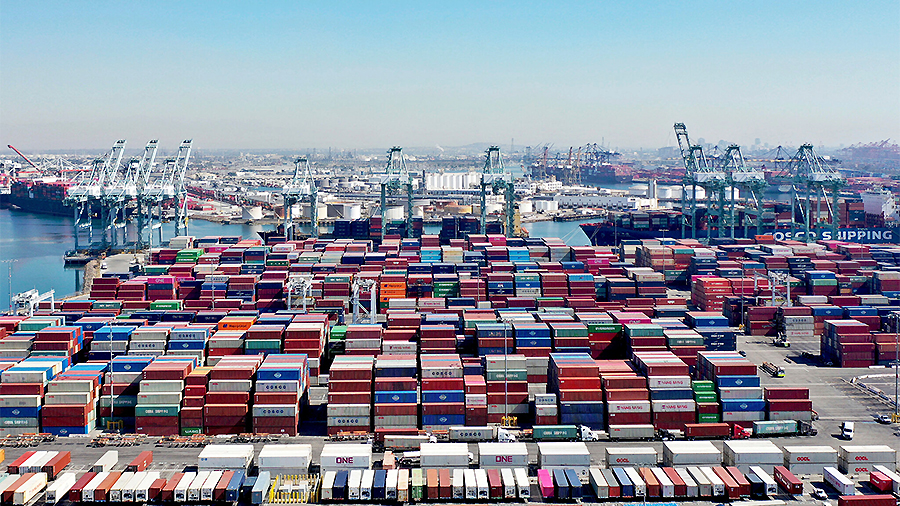Breaking its previous calendar year record by 13 percent, the Port of Los Angeles processed about 10.7 million Twenty-Foot Equivalent Units (TEUs) during 2021. The milestone, a Western Hemisphere record, was announced by Port Executive Director Gene Seroka in his address at the Pacific Merchant Shipping Association’s Seventh Annual “State of the Port” event held virtually this year.
“Decades of development provided the berth space, backland and rail infrastructure to process more cargo than ever before,” Seroka said. “In 2021, our marine terminal operators and workforce gave us the ability to move that cargo, from the ships to railcars or out the gates on trucks, and for that, we are forever grateful to them.”
Recapping the year, Seroka reiterated the importance of the industry coming together to address global supply chain challenges and highlighted the Port’s engagement with stakeholders at all levels of the industry and government to find solutions, including the Biden-Harris Administration and the office of California Governor Gavin Newsom.
Seroka applauded the renewed attention and government investments in U.S. ports, including the $17 billion earmarked in the recently passed national Infrastructure Investment and Jobs Act and the $2.3 billion Newsom committed in the California state budget for 2022.
“This level of funding represents a monumental opportunity for ports,” said Seroka. “Beyond freight system improvements, it will fund much-needed digital and cybersecurity infrastructure. It supports our creation of a future-ready goods movement workforce, and it aligns with our mission to lead the nation in the development of zero-emissions port drayage.”
Looking ahead, Seroka outlined key port initiatives and priorities for 2022, including:
- Supply Chain Efficiency: Initiatives to further digitize the supply chain and deliver digital solutions to port users will be top priority. Last year, the Port unveiled the Control Tower suite of data tools, expanding the Port Optimizer system developed by the Port in conjunction with Wabtec. The Control Tower aids cargo owners and service providers by delivering precise shipping intelligence and real-time insights on Port of Los Angeles cargo. In 2022, the Port will add further enhancements to the Port Optimizer and work with the Biden Administration to support a national Port data initiative to improve supply chain efficiency and global competitiveness.
- Workforce Development and Job Creation: Seroka emphasized the importance of workforce development and its critical contributions to the goods movement industry – from longshore labor to truck drivers and warehouse workers. The Port’s planned Goods Movement Training Campus, which will focus on worker skill development, up-skilling and re-skilling to address the industry’s rapidly changing needs, received a huge boost this month with a three-year, $110 million commitment from California Gov. Newsom in his proposed budget. The first in the U.S. specifically dedicated to the goods movement industry, the campus will also serve as a state resource for training workers on greener and zero-emission technologies. Further plans for the Training Campus will be announced later this year.
- Cybersecurity: Guarding against potential malicious cyber incidents that could threaten or disrupt cargo flow remains a continual focus for the Port. Seroka revealed that a first-of-its-kind port cyber defense system co-developed with IBM is now fully operational. This new Cyber Resilience Center serves as an early warning system and information sharing network for Port stakeholders. The Port has had an award-winning Cyber Security Operations Center for its internal systems since 2014, monitoring network traffic to prevent and detect cyber incidents under Port control. The Port has also maintained its ISO 27001 certification for cybersecurity, the only Port to have this certification.
- Environment: Reducing Port environmental impacts continues to be a primary focus. The Port is currently testing 107 zero-emission and 27 near-zero-emission units in the areas of cargo handling, drayage, harbor craft and ocean-going vessel operations, a number that will grow to more than 200 units over the next 18 months. More than a half-dozen manufacturers will deploy next-generation drayage trucks in and around the Port this year. Seroka also announced that the Port will begin collecting the Clean Truck Fund Rate in April, which is expected to raise $130 million over the next three years. Those funds will be used to fund zero-emission trucks and fueling infrastructure development.
The leading seaport by container volume and cargo value in the U.S., the Port of Los Angeles, facilitated $259 billion in trade during 2020. San Pedro Bay port complex operations and commerce facilitate one in nine jobs across Los Angeles, Orange, Riverside, San Bernardino, and Ventura. The Port of Los Angeles has remained open, with all terminals operational throughout the pandemic.
Photo courtesy NY Times















